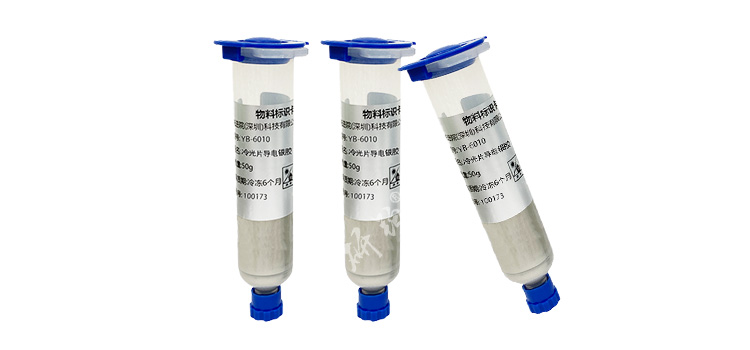

Hotline:0755-22277778
Tel:0755-22277778
Mobile:13826586185(Mr.Duan)
Fax:0755-22277776
E-mail:duanlian@xianjinyuan.cn
Epoxy conductive silver adhesiveIt usually refers to a conductive adhesive that uses epoxy resin as a polymer film-forming substance and as a conductive filler.
Epoxy resin refers to a general term for three-dimensional cross-linked cured compounds that contain two or more epoxy groups in a molecular structure and can be formed under appropriate chemical reagents and conditions. There are many types of them, and according to their chemical structure, they can be divided into glycidyl ethers, glycidyl esters, glycidyl amines, cycloaliphatic epoxy resins, epoxy resins containing inorganic elements, and new types of epoxy resins (such as hydantoin epoxy resins, imide epoxy resins, etc.). Among various types of epoxy resins, bisphenol A epoxy resin is the largest and most widely used variety, known as universal epoxy resin. However, its viscosity is high, and for applications with low viscosity requirements or containing a large amount of fillers, diluents need to be added to adjust the viscosity. Bisphenol F epoxy resin is a type of epoxy resin developed to reduce the viscosity of bisphenol A epoxy resin while maintaining the same properties. Its viscosity is less than one-third of that of bisphenol A epoxy resin, and the properties of the cured product are almost the same as those of bisphenol A epoxy resin. However, the heat resistance is slightly lower and the corrosion resistance is slightly better. uncured epoxy resin is a thermoplastic polymer oligomer, which has little practicality. Only by adding certain chemicals (such as curing agents or hardeners) appropriately and curing (or hardening) under certain conditions, can a three-dimensional network structure be formed into an insoluble and non melting cured product, which has excellent mechanical and adhesive properties and achieves the purpose of use. There are many types of curing agents for epoxy resin, according to The mechanism of curing reaction and the chemical structure of curing agents can be divided into two categories: visible and latent. Latent curing agent refers to a type of curing agent that, when mixed with epoxy resin, is relatively stable for a long time at room temperature (generally requiring more than 3 months to have significant use value, and ideally requiring six months or more than 1 year), and is exposed to heat, light, moisture, and other conditions before starting the curing reaction. This type of curing agent is basically activated by physical and chemical methods to encapsulate the curing agent. However, curing agents such as dicyandiamide and hydrazide triacetate, which are insoluble in dry epoxy resins at room temperature and begin to cure after dissolving at high temperatures, also exhibit a latent state. Therefore, they are sometimes classified as latent curing agents.
Curing agent is an indispensable curing reaction aid in the matrix resin, generally a multifunctional compoundConductive adhesiveIt is an important component that participates in the curing reaction, forming a network structure between the molecular chains of the polymer resin, and is also a part of the cured product, thereby changing the structure of the matrix resin. This not only improves the adhesive strength of the conductive adhesive, but also reduces the volume of the matrix resin, allowing the conductive filler to tightly contact inside the matrix resin, forming more conductive pathways and reducing the volume resistivity of the system. Common curing agents include amines, organic anhydrides, imidazole compounds, etc. In order to shorten the curing time, reduce the curing temperature, and improve the curing efficiency, accelerators can also be added to the system.

Conductive adhesiveThe viscosity can be adjusted by diluent. According to the usage mechanism, diluents can be divided into two categories: active diluents and reactive diluents. Non reactive diluents do not participate in crosslinking reactions, but only use physical dissolution to regulate viscosity. They need to be removed before the curing reaction, so they should generally have a large molecular weight, evaporate slowly, and contain polar structures such as carbon oxygen polar segments in their molecular structure. Reactive diluents generally refer to low molecular weight compounds with one or more epoxy groups. Therefore, reactive diluents can directly participate in the curing reaction and become part of the cross-linked network structure of the cured material, while having a small impact on the properties of the cured product, and sometimes increasing the toughness of the curing system.
There are many conductive adhesives using silver powder as a conductive filler, and most commercially available conductive adhesives are silver based conductive adhesives. Silver is the best conductive filler for high-performance conductive adhesives. At present, there are many research institutes and enterprises that study and produce silver powder, and there are also many types of silver powder due to their different particle sizes and shapes. When selecting silver powder, it is necessary to follow the specific requirements of the conductive adhesive for filling particles. Amorphous (sheet-like or fibrous) fillers have better conductivity and bonding strength than granular fillers, but anisotropic conductive adhesives can only use granular fillers with narrow particle size distribution. Compared to fillers with smaller particle sizes, fillers with larger particle sizes have better conductivity, but they may reduce adhesive strength. The combination of conductive fillers with different shapes and particle sizes can significantly improve certain properties of the conductive adhesive.
existConductive adhesiveAdding leveling and thixotropic agents can adjust the viscosity and printing properties of conductive adhesive. Adding oxygen scavengers (such as carbazide, hydrazine, etc.) to conductive adhesives can suppress electrochemical corrosion to a certain extent. Because deoxidizers can remove oxygen dissolved in water at the connection interface. Thereby suppressing electrochemical corrosion. Adding reinforcing and toughening agents can improve the strength and toughness of the cured conductive adhesive. In addition, in order to improve the conductivity and anti-aging properties of conductive adhesive and control the curing reaction, additives such as conductive accelerator, preservative, coupling agent and crosslinking agent can also be used.


Advanced Institute (Shenzhen) Technology Co., Ltd, © two thousand and twenty-onewww.avanzado.cn. All rights reservedGuangdong ICP No. 2021051947-1 © two thousand and twenty-onewww.xianjinyuan.cn. All rights reservedGuangdong ICP No. 2021051947-2